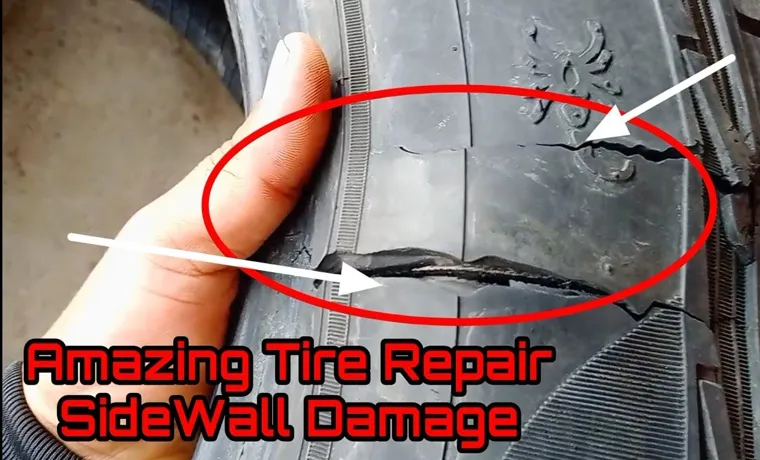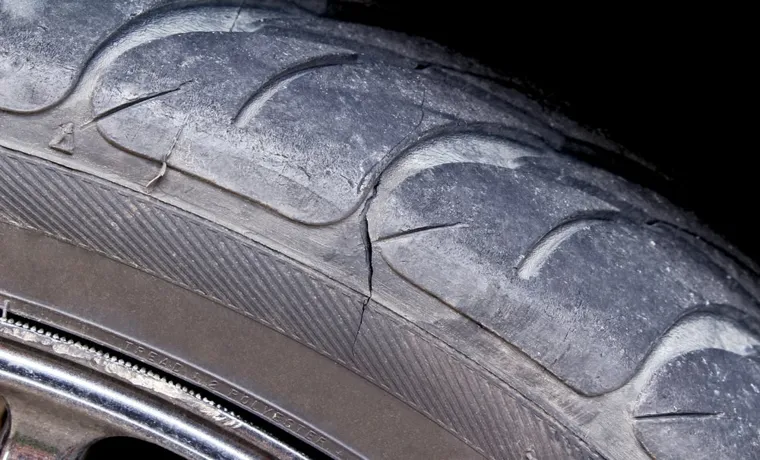When driving, all it takes is one stray rock or pothole to cause damage to your vehicle’s tires. One of the most common types of damage that you might encounter is sidewall damage. This kind of damage can be caused by a range of things including hitting the curb or driving over a sharp object.
Unfortunately, sidewall damage can’t always be fixed with a simple repair job. Understanding the extent of the damage is critical in determining whether the tire needs to be replaced or if it can continue to be used safely. In this blog, we’ll explore the different types of sidewall damage and the steps you should take to ensure that your vehicle remains safe on the road.
Table of Contents
What is a Tire Sidewall?
Have you ever noticed the side of your car’s tires? That’s what we call the tire sidewall. It’s the vertical part of the tire that connects the tread to the wheel rim. The sidewall is an extremely important part of the tire and is designed to absorb the impact and weight of your car.
However, it is often exposed to various elements such as stones, debris, potholes, curbs, and even UV rays that can cause damage. A damaged sidewall can lead to punctures, bulges, bubbles, and even blowouts. So, it’s important to regularly inspect your tire sidewalls for any cracks, cuts or any other damage.
If you notice any issues, it’s always best to have a professional mechanic take a look and decide whether it needs to be repaired or replaced. So, always remember to inspect your tire sidewalls and take care of them to keep your car in a safe and healthy condition.
Description of Tire Sidewall
A tire sidewall is the part of a tire that runs from the wheel rim to the tread surface. It is an essential component of a tire as it provides structural support, protects the tire from external damage, and carries crucial information about the tire’s characteristics. The sidewall is made of sturdy rubber and contains the tire’s size, maximum load capacity, speed rating, and other relevant manufacturing details.
Furthermore, the sidewall can provide clues about the tire’s performance features, such as its ability to handle different weather conditions and road surfaces. The sidewall’s design can be plain or patterned, with some tires featuring raised rubber blocks or lettering for enhanced traction or aesthetic appeal. Understanding the tire sidewall can help car owners choose the right tires for their vehicle and optimize their driving experience.
So, next time you’re shopping for tires, take a close look at the sidewall to get a better idea of what you’re getting.

Causes of Tire Sidewall Damage
Tire sidewalls are designed to be durable to withstand the pressure and forces that tires undergo while on the road. However, they can still get damaged due to a variety of reasons. One common cause of tire sidewall damage is hitting a pothole or curb.
This can cause a blowout, cracking, or bulging of the sidewall. Overloading your vehicle can also lead to sidewall damage as this puts extra strain on your tires. Another reason for sidewall damage is prolonged exposure to sunlight, which can cause the rubber to deteriorate over time.
Additionally, driving on rough or unpaved roads can also lead to sidewall damage as debris or rocks can puncture the sidewall. It’s important to regularly inspect your tires for signs of sidewall damage as it can impair the overall performance and safety of your vehicle. By being proactive and taking preventative measures, you can prolong the lifespan of your tires and ensure your safety while driving.
Potholes
Driving over potholes is one of the leading causes of tire sidewall damage. Potholes are a serious problem on roads, especially during the wet season, and can cause significant damage to cars. A pothole is formed when the surface of the road begins to erode due to weather elements like rain, cold, and heat.
This usually weakens the road’s surface, leading to the formation of holes. The impact of driving over a pothole can be quite severe as it exerts tremendous stress on the tires. The force of the impact can cause the tire sidewall to bulge or even burst.
It is wise to avoid potholes whenever possible as they can impact not only your tires but also the suspension system of your vehicle. If you can’t avoid them, try to reduce your speed while driving over them to minimize the damage. Regularly inspect your car’s tires to ensure they are in good condition; if you spot any damage, have them checked and fixed by a professional.
Remember, the safety of your vehicle is crucial, and avoiding potholes is one of the best ways to ensure it.
Overloading the Vehicle
Overloading your vehicle can be a recipe for disaster, and one of the most common issues that can occur as a result is tire sidewall damage. This happens when you exceed your vehicle’s maximum weight limit, causing your tires to bear too much weight and resulting in wear and tear on the sidewall. Frequent overloading can cause the tire to blow out suddenly when driving, which can be extremely dangerous.
It’s important to ensure that you’re staying within your vehicle’s weight limit, as well as making sure that your tires are properly inflated and in good condition. Don’t risk your safety and the safety of others on the road by overloading your vehicle – take the time to properly load it and keep your tires in good shape. Remember, prevention is always better than cure!
Underinflated Tires
Underinflated tires can be a major cause of sidewall damage to your vehicle’s tires. When a tire is underinflated, the sidewalls can flex and weaken, leading to cracks, bulges, and even blowouts. In addition to being a safety hazard, this can also cause significant wear and tear on your tires, reducing their overall lifespan.
But why do tires become underinflated in the first place? Well, in many cases, it’s simply a matter of neglect. Many drivers fail to check their tire pressure regularly, and as a result, their tires can become underinflated over time. Other causes of underinflation may include a leak or puncture in the tire, or a malfunctioning valve stem.
Whatever the cause, it’s important to address the issue as quickly as possible to avoid further damage. Regular tire maintenance, including regular inspections and filling tires to the manufacturer’s recommended pressure, can help prevent sidewall damage and ensure your vehicle remains safe and reliable on the road.
Curbing the Tire
Tire sidewall damage is not uncommon and can be caused by a variety of factors. One of the most common causes is hitting a curb or pothole. When you hit a curb, the sidewall can become pinched or sliced, leading to a weakened tire and eventual failure.
Potholes can be even more damaging, as they can cause a blowout or other structural damage to the tire. Another cause of sidewall damage is overloading. The weight of a heavy load can place excess stress on the sidewalls, leading to cracks or bulges.
This is why it’s important to always follow your vehicle’s load capacity guidelines. Additionally, extreme weather conditions such as high temperatures or freezing temperatures can cause sidewall damage over time. It’s important to regularly inspect your tires for any signs of damage, as a damaged sidewall can cause a blowout or other tire failure while driving.
By being aware of these potential causes and taking steps to prevent them, you can help ensure that your tires stay in good condition for longer.
Heat and Aging
Heat and Aging When it comes to tire sidewall damage, heat and aging are two of the most common culprits. Exposure to high temperatures can cause the rubber to dry out and become brittle, which can lead to cracking or even a blowout. This is especially true in areas with extreme heat, such as the southern United States.
Additionally, as tires age they naturally break down and become less flexible. This can lead to cracking and other types of damage as well. One way to combat the effects of heat and aging is to make sure your tires are properly inflated and rotated on a regular basis.
This can help distribute wear and tear more evenly, which can extend the life of the tire. It’s also important to inspect your tires regularly for any signs of damage, and to replace them when they begin to show significant signs of wear. By taking these steps, you can help prevent tire sidewall damage and keep yourself and others safe on the road.
Signs of Sidewall Damage
Tire sidewalls are typically made of rubber, which is designed to be durable and resilient. However, there are a few different factors that could cause damage to the sidewalls of your tires. One common cause of sidewall damage is impact with a curb or other object while driving.
This can cause small cuts or punctures in the sidewall, which could eventually lead to a blowout if left unrepaired. Extreme temperatures can also cause damage to tire sidewalls, as rubber can become brittle and crack in extreme hot or cold temperatures. Improper inflation or overloading your vehicle can also put excess stress on your tire sidewalls, causing them to wear down and eventually fail.
If you’re experiencing any of these issues, it’s important to have your tires inspected by a professional to ensure that they’re safe to drive on.
Visible Cuts and Scuffs
Visible cuts and scuffs on the sidewall of your tires can be a sign of damage. Sidewall damage can occur from hitting a curb, pothole, or debris on the road. It can also happen from extreme weather conditions and improper inflation.
The sidewall of the tire is the only part that holds the weight of your vehicle and provides stability during cornering. When the sidewall is damaged, it can compromise the strength and integrity of the tire, leading to a blowout or a flat tire. It is essential to inspect your tire’s sidewall regularly and look for cuts, punctures, cracks, and bulges.
If you notice any signs of sidewall damage, it is best to replace the tire immediately to avoid any potential hazards. Remember, driving on damaged tires can put you and your passengers at risk, and it’s not worth the consequences. Stay safe on the road by being vigilant and taking care of your vehicle’s maintenance needs.
Bulges and Blisters
Sidewall damage can be a serious issue for any vehicle. If ignored, it can lead to punctures, blowouts, and loss of control while driving at high speeds. It’s important to know the signs of sidewall damage, which can include bulges and blisters.
These are areas where the rubber appears to be stretched or pushed outwards, indicating that the tire’s internal structure may be compromised. In some cases, you may even be able to see the cords that wrap around the tire’s circumference. If you notice any bulges or blisters, it’s important to get your tire inspected by a professional as soon as possible.
It’s also a good idea to inspect your tires regularly for any signs of damage, as catching it early can save you from a dangerous situation on the road.
Preventing Tire Sidewall Damage
One of the most common types of tire damage is sidewall damage, which can be caused by various factors such as potholes, curbs, and road debris. This type of damage is particularly dangerous as it can lead to a sudden tire blowout, resulting in a loss of control and a potentially life-threatening situation. To prevent sidewall damage, it is important to drive carefully and avoid hitting curbs or potholes at high speeds.
Additionally, maintaining proper tire pressure and inspecting your tires regularly for signs of wear or damage can also help prevent sidewall damage. If you do notice any bulges, cuts, or other signs of damage on your tire sidewalls, it is important to replace them immediately to ensure your safety on the road. By taking these simple steps, you can help prevent sidewall damage and feel confident and secure while driving your vehicle.
Conclusion
In conclusion, the tire sidewall is like the protective armor of our vehicle’s wheels, shielding them from potential harm and ensuring a smooth ride. However, just like any armor, it can become damaged when exposed to certain external factors such as potholes, curbs, extreme temperatures, and even overinflating or underinflating. Therefore, it is crucial to regularly inspect and maintain your tires’ sidewalls to prevent any unexpected blowouts or accidents on the road.
Remember, a little care goes a long way in keeping your wheels rolling.”
FAQs
What are some common causes of tire sidewall damage?
Tire sidewall damage can be caused by hitting curbs or potholes, overloading the vehicle, underinflating the tires, or driving on rough terrain.
How can you tell if your tire sidewall has been damaged?
Look for cracks, bulges, or cuts on the sidewall of the tire. Additionally, if you notice your tire losing air without an obvious puncture, it could be due to sidewall damage.
Is tire sidewall damage dangerous?
Yes, sidewall damage can be dangerous as it can lead to tire blowouts while driving. It’s important to inspect your tires regularly and replace any tires with sidewall damage.
Can tire sidewall damage be repaired?
No, tire sidewall damage cannot be repaired. It’s important to replace the damaged tire with a new one to ensure safe driving.
Does tire age play a role in sidewall damage?
Yes, as a tire gets older, the sidewall can become weaker and more vulnerable to damage. It’s important to replace tires after 6 years, regardless of the amount of wear.
Will tire sidewall damage affect the vehicle’s performance?
Yes, tire sidewall damage can affect the vehicle’s handling, stability, and fuel efficiency. It’s important to replace damaged tires to ensure optimal performance.
How can you prevent tire sidewall damage?
To prevent tire sidewall damage, avoid driving on rough roads or hitting curbs and potholes. Keep your tires properly inflated and replace them after 6 years or if signs of damage are present.




